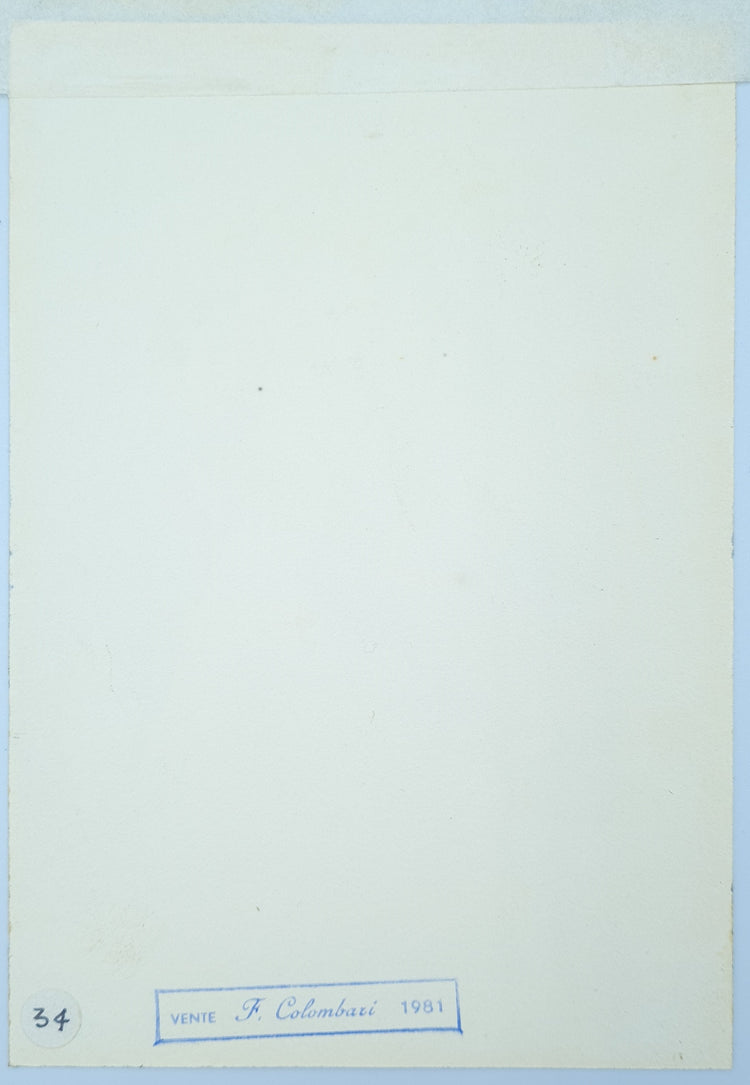Franz Colombari, American missionary in Tehran, 1848.
- Regular price
- €4.700,00 EUR
- Regular price
-
- Sale price
- €4.700,00 EUR
- Unit price
- per
American missionary Joseph Gallup Cochran in Tehran, Iran
Franz Colombari (Smyrna 1813-Paris 1879).
Portrait of Joseph Gallup Cochran and Conrad Gustav Fagergren.
Tehran, Persia (Iran), 1848.
Watercolour and pencil on wove paper. 16,5 x 11,5 cm. Stamp on verso “vente F. Colombari 1981”. Manuscript title on paper pasted on back of mount: “Un Suèdois et un Américain du passage à Tehéran, F. Colombari”.
Rare image of one of the early American missionaries to Iran: Rev. Joseph Gallup Cochran. He is portrayed here by prolific Orientalist artist Franz Colombari, together with Swedish physician Dr Conrad Gustav Fagergren.
This drawing a strong record of Western presence in Iran in the mid-19th century. Cochran, Colombari and Fagergren were close to the people in power at the Tehran court during a period when the Qajar Shah opened the country to Western influence. Colombari had good ties with the Aqasi (grand vizier) Haji Mirza Abbas Iravani (Persian: حاجی میرزا عباس ایروانی), Fagergren was the physician of the Shah and Cochran was to lead the influential Presbyterians in the Urumia region. Fagergren had just arrived in Tehran in 1847 and Cochran in 1848. Colombari had been at the court for several years already. The present drawing was made shortly after Cochran’s arrival because the men were dispersed when the Shah died in 1848. As the deceased Shah’s physician Fagergren had to flee. Colombari on the other hand was a close confidant of crown prince Naser al-Din Shah Qajar who became Shah in 1848. Cochran moved to Urmia for his missionary work.
American missionary Cochran was an Amherst College graduate. He was a Presbyterian minister, sent as a missionary to Persia. His son Dr. Joseph P. Cochran is better known, a.o. for being the founder of Urmia's First Medical College . American missionaries were active in Iran since 1834, where they helped the local Christian population in the Urumia region, especially by opening schools and developing education. The first school for boys opened in Urumia in 1836 and for girls in 1838. Shortly after opening schools for local Iranian Christians, the Presbyterians changed direction and opened separate schools for Muslims at the request of Mohammad Shah.
Condition: in very good condition
Provenance: Etienne Mercier, Paris: 'Le Colonel F. Colombari et autres voyageurs de l’Orient du XIXe au debut du XXe siècle', Salle Drouot, 19 June 1981; Galerie Soustiel, Paris, 1985; Olympia Auctions, London, 2023.
Literature:
Gerald H Anderson, David M. Stowe. "Cochran, Joseph Gallup (1817–1871)". In: Biographical Dictionary of Christian Missions. Wm. B. Eerdmans Publishing, 1999. p. 140.
Jasamin Rostam-Kolayi. “From Evangelizing to Modernizing Iranians: The American Presbyterian Mission and Its Iranian Students.” In: Iranian Studies, vol. 41, no. 2, 2008, pp. 213–39.
Joseph G. Cochran, The Persian Flower: A Memoir of Judith Grant Perkins, of Oroomiah, Persia. Boston, American Tract Society, 1853.
Couldn't load pickup availability
Share



Contact
Email: hugo@artemrarebooks.com
Phone: +31651042297
Visit us on appointment at:
Former US Embassy
Lange Voorhout 102
2514EJ
The Hague (The Netherlands)
Shipping address:
Nannie van Wehlstraat 51
2548MN
The Hague
The Netherlands



